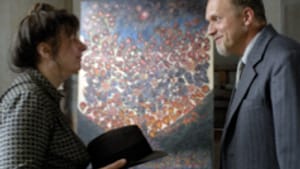Stay in the Loop
BSR publishes on a weekly schedule, with an email newsletter every Wednesday and Thursday morning. There’s no paywall, and subscribing is always free.
A few words about art
Martin Provost's 'Séraphine' at the Ritz Five

In Martin Provost's beautiful Séraphine we get to know the painter Séraphine de Senlis (Yolande Moreau) only gradually. As we follow her through her daily routine— cooking, cleaning and doing laundry for the petit-bourgeoisie of Senlis, a small town north of Paris— it gradually becomes clear that the lumpen Séraphine has a rich interior life with a strong spiritual component. Even more gradually, we learn that she expresses that interior life through painting.
One of the women she cleans for rents a flat to Wilhelm Uhde (Ulrich Tukur), a German art critic, collector and advocate of primitivist art (in addition to his support of Picasso, he "discovered" Rousseau). Séraphine starts working for Uhde as a cleaning lady and finds him intriguing: She examines some Picasso sketches he has on hand for a monograph he's writing, compliments his beautiful handwriting, and recommends he get out into nature to combat the blues. But Séraphine remains almost invisible to Uhde until he comes across one of her paintings in his landlady's flat. Uhde is immediately struck by Séraphine's work and encourages her to devote herself to her art.
The inarticulate painter
Provost (who directed and co-authored the screenplay) makes the relationship between Séraphine and Uhde the centerpiece of the film, focusing specifically on how they do, or more often don't, communicate with each other. The chasm that separates them is deeper than that of nationality or social class, though class obviously plays a role. Uhde writes about art while Séraphine makes it; Uhde inhabits a world of words— both spoken and written— from which the profoundly inarticulate Séraphine is excluded.
As Séraphine makes her daily rounds, she exchanges as few words as possible with those she encounters. Her main vocalizations are the hymns she sings, both in church and as she paints. (No subtitles for the lyrics of those hymns are provided; for those of us who don't speak French, they are sounds only.) In fact, when Séraphine stops singing as she paints and starts talking instead, her neighbors recognize it as a sign of her deteriorating mental state.
Similarly, Séraphine values the appearance of words far more than what they signify. At one point she asks Uhde, who's returning to his home in Chantilly, to write to her in his beautiful handwriting. For her, the medium clearly trumps the message.
A walk in the woods
Provost doesn't romanticize Séraphine — she's no Noble Savage, as idealized by the other Rousseau— but he does portray her as living in a world of unmediated experience. Uhde, on the other hand, can't achieve that directness of sensation: When he takes the walk in the woods that Séraphine recommends, you can practically see him thinking, "Here I am, walking in the woods."
Because of these differences, Séraphine and Uhde can be no more than partially successful in their efforts to communicate, despite the enormous good will they bear towards each other. The poignancy arises from the fact that neither of them ever fully realizes that they're not communicating.
One of the women she cleans for rents a flat to Wilhelm Uhde (Ulrich Tukur), a German art critic, collector and advocate of primitivist art (in addition to his support of Picasso, he "discovered" Rousseau). Séraphine starts working for Uhde as a cleaning lady and finds him intriguing: She examines some Picasso sketches he has on hand for a monograph he's writing, compliments his beautiful handwriting, and recommends he get out into nature to combat the blues. But Séraphine remains almost invisible to Uhde until he comes across one of her paintings in his landlady's flat. Uhde is immediately struck by Séraphine's work and encourages her to devote herself to her art.
The inarticulate painter
Provost (who directed and co-authored the screenplay) makes the relationship between Séraphine and Uhde the centerpiece of the film, focusing specifically on how they do, or more often don't, communicate with each other. The chasm that separates them is deeper than that of nationality or social class, though class obviously plays a role. Uhde writes about art while Séraphine makes it; Uhde inhabits a world of words— both spoken and written— from which the profoundly inarticulate Séraphine is excluded.
As Séraphine makes her daily rounds, she exchanges as few words as possible with those she encounters. Her main vocalizations are the hymns she sings, both in church and as she paints. (No subtitles for the lyrics of those hymns are provided; for those of us who don't speak French, they are sounds only.) In fact, when Séraphine stops singing as she paints and starts talking instead, her neighbors recognize it as a sign of her deteriorating mental state.
Similarly, Séraphine values the appearance of words far more than what they signify. At one point she asks Uhde, who's returning to his home in Chantilly, to write to her in his beautiful handwriting. For her, the medium clearly trumps the message.
A walk in the woods
Provost doesn't romanticize Séraphine — she's no Noble Savage, as idealized by the other Rousseau— but he does portray her as living in a world of unmediated experience. Uhde, on the other hand, can't achieve that directness of sensation: When he takes the walk in the woods that Séraphine recommends, you can practically see him thinking, "Here I am, walking in the woods."
Because of these differences, Séraphine and Uhde can be no more than partially successful in their efforts to communicate, despite the enormous good will they bear towards each other. The poignancy arises from the fact that neither of them ever fully realizes that they're not communicating.
What, When, Where
Séraphine. A film directed by Martin Provost. In French with English subtitles. At the Ritz 5, 214 Walnut St., (215) 925-7900 or www.landmarktheatres.com. Also the Bryn Mawr Film Institute, 824 Lancaster Ave., Bryn Mawr, Pa. (610-527-1319 or www.brynmawrfilm.org) and County Theater, 20 E. State St., Doylestown, Pa. (215-345-6789 or www.countytheater.org).
Sign up for our newsletter
All of the week's new articles, all in one place. Sign up for the free weekly BSR newsletters, and don't miss a conversation.

 Judy Weightman
Judy Weightman